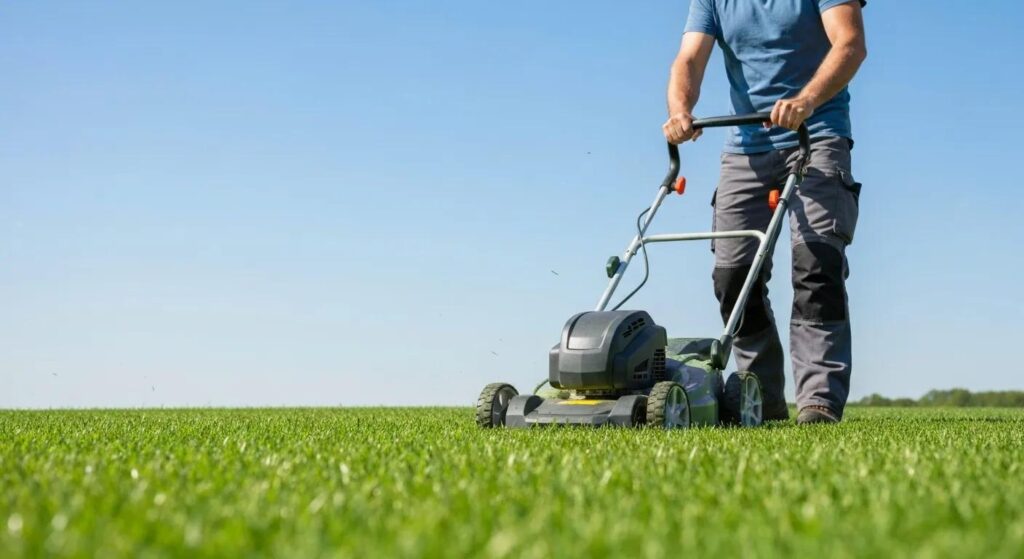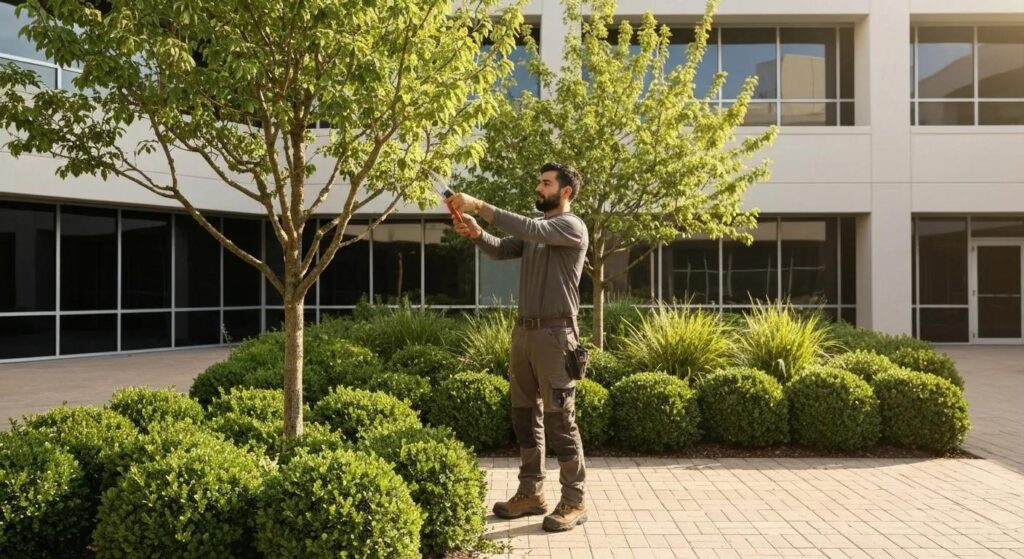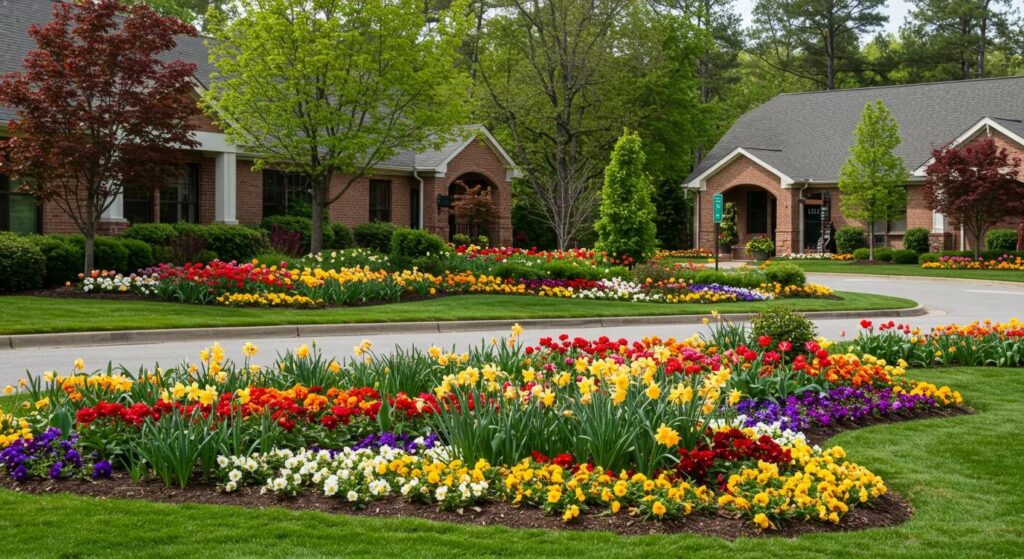Expert Tips for Commercial Landscape Maintenance Services to Enhance Property Value and Efficiency
Imagine a commercial landscape so well-maintained, it not only elevates your property’s value by up to 10% but also slashes operational costs through smart resource management. In this expert guide, we’ll walk you through the must-have services that keep your outdoor spaces immaculate, the perfect maintenance schedule, how to choose the right landscaping partner, and the tangible benefits of professional care. Plus, we’ll share sustainable strategies tailored for businesses in Greater Phoenix. With insights from HEOSAZ, a family-owned leader in commercial landscape maintenance, you’ll gain actionable tips to boost curb appeal, operational efficiency, and environmental stewardship across your property portfolio.
What Are the Essential Commercial Landscape Maintenance Services?
Commercial landscape maintenance is all about a suite of core tasks designed to keep outdoor environments for businesses, HOAs, and institutions looking their best. These activities ensure your turf, plants, irrigation, and hardscapes are functional and attractive all year round.
| Service | Attribute | Outcome |
|---|---|---|
| Lawn Care | Mowing, fertilization, weed control | Uniform, vibrant turf |
| Tree and Shrub Care | Pruning, health monitoring | Healthy woody plants |
| Irrigation Management | Smart scheduling, sensor calibration | Optimized water consumption |
| Hardscape Maintenance | Joint sealing, cleaning | Safe, durable outdoor surfaces |
Each service targets specific landscape elements, forming a comprehensive maintenance program that sustains both aesthetics and functionality.
Which Core Services Are Included in Commercial Landscape Maintenance?
Core commercial maintenance services include routine mowing, fertilization, irrigation checks, pruning, and hardscape repairs to ensure your property always looks its best. Mowing keeps grass at the right height, fertilization provides essential nutrients, irrigation tests prevent over- or under-watering, pruning shapes plant growth, and hardscape care maintains material integrity. Understanding these tasks clarifies the full scope of expert landscape maintenance.
How Does Lawn Care Improve Commercial Property Appearance?

Lawn care is key to curb appeal, maintaining even turf color and density, which projects professionalism and invites clients.
- Mow turf at consistent heights to promote uniform growth.
- Apply balanced fertilizers seasonally to sustain green color.
- Implement integrated weed management to prevent unsightly patches.
Regular turf management transforms open spaces into polished grounds that reflect brand standards and reinforce property value.
What Are Best Practices for Tree and Shrub Care in Commercial Settings?

Proper tree and shrub care preserves plant health and structural integrity, reducing disease risk and enhancing canopies.
- Conduct seasonal pruning to remove dead or interfering limbs.
- Perform health assessments to detect pests and diseases early.
- Apply organic mulches to regulate soil moisture and temperature.
These practices protect woody elements and support overall landscape vitality, leading seamlessly into water-efficient irrigation strategies.
How Is Irrigation System Management Critical for Water Conservation?
Irrigation management leverages smart controllers and sensor-based scheduling to deliver precise water volumes, conserving resources while maintaining plant hydration.
- Install soil moisture sensors to trigger irrigation only when needed.
- Program weather-based controllers to adjust schedules automatically.
- Conduct quarterly audits to check for leaks and optimal coverage.
Optimized irrigation is the backbone of sustainable maintenance and sets the stage for preserving hardscape integrity.
Why Is Hardscape Maintenance Important for Commercial Properties?
Hardscape maintenance preserves walkways, patios, and retaining walls through joint sealing and debris removal, ensuring safety and longevity.
- Pressure wash surfaces to remove mildew and stains.
- Repair or replace cracked pavers to prevent trip hazards.
- Apply sealants annually to protect against UV and moisture damage.
Maintaining hardscapes completes a holistic maintenance plan and informs appropriate service frequency.
How Often Should Commercial Landscape Maintenance Be Performed?
Maintenance frequency determines landscape resilience, with tailored schedules aligning tasks to seasonal growth cycles and environmental stressors. The following table provides a recommended seasonal schedule for commercial properties in the Greater Phoenix area.
| Season | Primary Tasks | Frequency |
|---|---|---|
| Spring | Pre-emergent weed control, fertilization | Monthly |
| Summer | Irrigation calibration, mowing | Bi-weekly |
| Fall | Leaf removal, aeration | Monthly |
| Winter | Dormant pruning, system winterization | Quarterly |
What Is the Recommended Seasonal Maintenance Schedule?
A seasonal maintenance schedule maps specific services to growth phases, optimizing resource allocation and plant health. Spring focuses on soil preparation and green-up treatments; summer emphasizes consistent irrigation and turf cutting; fall targets cleanup and rejuvenation; winter prepares systems for dormancy. Following this schedule prevents over- or under-servicing landscapes.
How Do Seasonal Changes Affect Commercial Landscape Care?
Temperature extremes and monsoon rains impact plant metabolism and water requirements, necessitating technique modifications. Summer heat increases evapotranspiration, demanding more frequent irrigation checks, while cooler winter months allow for structural pruning and routine inspections without active growth. Monitoring weather patterns informs timely interventions and resource allocation.
What Are the Signs That Indicate Immediate Maintenance Is Needed?
Visible turf browning, wilting foliage, pooling water, or cracked pavers signal emergent issues requiring prompt attention to prevent escalation.
- Brown patches or thinning turf indicate irrigation or soil compaction problems.
- Leaf scorch and branch die-back reveal drought stress or disease.
- Water accumulation around drains suggests system malfunctions.
- Surface cracks or uneven stones create safety hazards.
Early detection of these indicators safeguards landscape integrity and directs partner selection moving forward.
How Can Property Managers Choose the Right Commercial Landscaping Partner?
Selecting a landscaping partner involves evaluating credentials, service scope, and alignment with sustainability goals to ensure reliable performance and environmental accountability. The criteria below guide informed decisions.
What Criteria Should Be Used to Evaluate Commercial Landscaping Companies?
Key evaluation criteria include proof of licensing, comprehensive insurance coverage, documented experience, and structured quality assurance processes that guarantee service consistency.
- Verify state and local landscape contractor licenses.
- Confirm liability and workers’ compensation insurance.
- Review years of experience managing similar properties.
- Assess quality control protocols and reporting standards.
Assessing these attributes ensures a partner can deliver on performance and risk management priorities.
How Do Sustainability Practices Influence Partner Selection?
A partner’s sustainability protocols—like water-smart irrigation, organic soil amendments, and native plant integration—demonstrate commitment to resource conservation and regulatory compliance.
- Look for automated irrigation with evapotranspiration programming.
- Request use of organic fertilizers and integrated pest management.
- Ensure native and drought-tolerant species are prioritized.
Green practices differentiate providers and uphold corporate responsibility.
Why Is Customer Satisfaction and Portfolio Review Important?
Reviewing client testimonials and project portfolios verifies a provider’s ability to achieve desired outcomes, fostering trust and aligning expectations with demonstrated results.
- Evaluate case studies showcasing before-and-after transformations.
- Read verified reviews from property managers and HOAs.
- Inspect photo galleries for consistency in design and maintenance.
A thorough portfolio review confirms both aesthetic standards and service reliability before commitment.
What Are the Benefits of Professional Commercial Landscape Maintenance?
Professional maintenance boosts curb appeal, reduces long-term costs, and mitigates liability risks through expert interventions that uphold safety standards and regulatory compliance.
- Enhanced Brand Image: Consistent, pristine landscapes reflect positively on businesses and improve property valuations.
- Cost Efficiency: Preventive care reduces emergency repairs and extends equipment and plant lifespans.
- Risk Reduction: Regular inspections and repairs minimize liability exposure from slips, trips, and pest hazards.
Understanding these benefits underscores ROI and drives investment in expert services.
How Does Professional Maintenance Improve Curb Appeal and Property Value?
Expert maintenance ensures uniform plant health and design integrity, enhancing visual appeal that positively influences market valuation and tenant attraction. Partnering with HEOSAZ means leveraging two decades of local expertise to produce landscapes that impress stakeholders and prospects alike.
What Cost Savings Can Be Achieved Through Expert Landscape Care?
Investing in professional care reduces reactive expenditures by up to 30 percent through optimized fertilization, preventive pest management, and efficient irrigation. These savings compound over time as equipment and hardscape elements endure fewer stress-related failures.
How Does Maintenance Enhance Safety and Compliance for Commercial Properties?
Routine inspections and corrective actions maintain clear walkways, safe retaining structures, and properly functioning irrigation, ensuring compliance with local safety codes and reducing liability for property managers.
What Are Key Expert Tips for Sustainable Commercial Landscape Maintenance?
Sustainable maintenance integrates water conservation, native species, and eco-friendly inputs to reduce environmental impact while preserving landscape beauty.
How Does Xeriscaping Benefit Arizona Commercial Properties?
Xeriscaping uses drought-tolerant plants and efficient irrigation to lower water usage by up to 60 percent, cut maintenance frequency, and create resilient landscapes suited to the Sonoran climate.
What Smart Irrigation Technologies Optimize Water Usage?
Automated controllers with weather-based programming, soil moisture sensors, and remote monitoring platforms enable precise scheduling and real-time adjustments, minimizing waste and adapting to sudden weather changes.
How Can Eco-Friendly Practices Reduce Environmental Impact?
Incorporating organic fertilizers, beneficial insect releases for pest control, and compost-based soil amendments fosters soil health, minimizes chemical runoff, and supports local biodiversity.
Engaging HEOSAZ’s sustainable maintenance division ensures your property benefits from the latest eco-innovations while aligning with Arizona’s water-use regulations.
Take the next step toward a healthier, more attractive commercial landscape by reaching out to our team—Contact Us to request a customized maintenance quote today.

